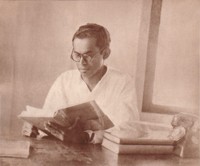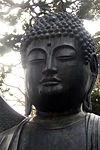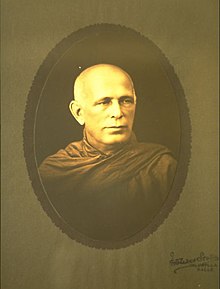Buddhism in the West broadly encompasses the knowledge and practice of Buddhism outside of Asia in the Western world. Occasional intersections between Western civilization and the Buddhist world have been occurring for thousands of years. The first Westerners to become Buddhists were Greeks who settled in Bactria and India during the Hellenistic period. They became influential figures during the reigns of the Indo-Greek kings, whose patronage of Buddhism led to the emergence of Greco-Buddhism and Greco-Buddhist art. There was little contact between the Western and Buddhist cultures during most of the Middle Ages but the early modern rise of global trade and mercantilism, improved navigation technology and the European colonization of Asian Buddhist countries led to increased knowledge of Buddhism among Westerners. This increased contact led to various responses from Buddhists and Westerners throughout the modern era. These include religious proselytism, religious polemics and debates, Buddhist modernism, Western convert Buddhists and the rise of Buddhist studies in Western academia. During the 20th century, there was a growth in Western Buddhism due to various factors such as immigration, globalization, the decline of Christianity and increased interest among Westerners. The various schools of Buddhism are now established in all major Western countries making up a small minority in the United States, Europe, Australia and New Zealand.

The World Fellowship of Buddhists (WFB) is an international Buddhist organization. Initiated by Gunapala Piyasena Malalasekera, it was founded in 1950 in Colombo, Ceylon, by representatives from 27 nations. Although Theravada Buddhists are most influential in the organization,, members of all Buddhist schools are active in the WFB. It now has regional centers in 40 countries, including India, the United States, Australia, and several nations of Africa and Europe, in addition to traditional Buddhist countries.

Buddhism is a minority religion in Switzerland. According to the 2000 census, 21,305 Swiss residents self-identified as Buddhists. About a third of them were born in Thailand.

Although there was regular contact between practising Buddhists and Europeans in antiquity the former had little direct impact. In the latter half of the 19th century, Buddhism came to the attention of Western intellectuals and during the course of the following century the number of adherents has grown. There are now between 1 and 4 million Buddhists in Europe, the majority in Italy, Germany, Hungary, France and the United Kingdom.

Nyanaponika Thera or Nyanaponika Mahathera was a German-born Theravada Buddhist monk and scholar who, after ordaining in Sri Lanka, later became the co-founder of the Buddhist Publication Society and author of numerous seminal books and articles on Theravada Buddhism. He mentored and taught a whole generation of Western Buddhist leaders such as Bhikkhu Bodhi.
Nissarana Vanaya is a meditation monastery in Sri Lanka. It is located in Mitirigala in the Western Province close to the town of Kirindiwela.

Ven. Nyanatiloka Mahathera, born as Anton Walther Florus Gueth, was one of the earliest Westerners in modern times to become a Bhikkhu, a fully ordained Buddhist monk.

The German Dharmaduta Society is an organization established to promote Buddhism in Germany and other Western Countries, and was founded by Asoka Weeraratna, in Colombo, Sri Lanka on 21 September 1952.
Sister Uppalavannā was a German violinist who converted to Buddhism, becoming the first European Buddhist nun since the time of Greco-Buddhism. She lived as an ascetic in Sri Lanka from 1926 until her death.

Island Hermitage on (Polgasduwa) Dodanduwa Island, Galle District, Sri Lanka is a famous Buddhist forest monastery founded by Ven Nyanatiloka Mahathera in 1911. It is a secluded place for Buddhist monks to study and meditate in the Buddhist tradition, and it contains an English and German library.
Ven. Kaṭukurunde Ñāṇananda Mahathera was a Sri Lankan Bhikkhu and Buddhist scholar. He is best known for the research monograph Concept and Reality in Early Buddhist Thought and the exploratory study The Magic of the Mind. Ven. Ñāṇananda was the abbot of Pothgulgala Aranya, a small forest monastery in Devalegama, Sri Lanka.

A bhikkhunī or bhikṣuṇī is a Buddhist nun, fully ordained female in Buddhist monasticism. Bhikkhunis live by the Vinaya, a set of either 311 Theravada, 348 Dharmaguptaka, or 364 Mulasarvastivada school rules. Until recently, the lineages of female monastics only remained in Mahayana Buddhism and thus were prevalent in countries such as China, Korea, Taiwan, Japan, and Vietnam, while a few women have taken the full monastic vows in the Theravada and Vajrayana schools. The official lineage of Tibetan Buddhist bhikkhunis recommenced on 23 June 2022 in Bhutan when 144 nuns were fully ordained.

Sīlācāra Bhikkhu, born and died as John Frederick S. McKechnie. He became a Buddhist monk in 1906 and was one of the earliest westerners in modern times to do so.

Das Buddhistische Haus is a Theravada Buddhist temple complex (Vihara) in Frohnau, Berlin, Germany. It is considered to be the oldest and largest Theravada Buddhist center in Europe and has been declared a National Heritage site.

Arya Maitreya Mandala is a tantric and Buddhist order founded 1933 by Lama Anagarika Govinda.
More than 60 percent of Berlin residents have no registered religious affiliation. As of 2010, at least 30 percent of the population identified with some form of Christianity, approximately 8.1 percent were Muslim, 1 percent were Jewish, and 1 percent belonged to other religions. As of 2018, the number of registered church members has shrunk to 14.9 percent for EKD Protestants and 8.5 percent for Catholics.
Kotahene Soma Maha Thera, born as Victor Emmanuel Perera Pulle in Kotahena, Colombo, was a Theravada Buddhist monk, translator and missionary.

Asoka Weeraratna was a Sri Lankan (Sinhala) Buddhist missionary, who founded the German Dharmaduta Society in 1952. He is also the founder of the Berlin Buddhist Vihara, one of the oldest Buddhist temples in Europe and Mitirigala Nissarana Vanaya, a famous meditation monastery in the Western Province, Sri Lanka. Asoka Weeraratna later entered the Order of Buddhist monks in 1972 as Ven. Mitirigala Dhammanisanthi Thera and spent his later life as a forest monk at the Mitirigala Nissarana Vanaya for a period of 27 years.
Paul Dahlke was a German physician and one of the founders of Buddhism in Germany. He wrote extensively about Buddhist teaching and living and translated Buddhist literature into German. In 1924 he established “Das Buddhistische Haus” considered to be the first Buddhist temple in Europe.
Deutsche Buddhistische Union is a German national umbrella organisation for Buddhist associations registered in Germany. DBU has estimated that there are 250 000 Buddhists in Europe and the religion is growing. As of June 2021 DBU has 62 member organizations.












